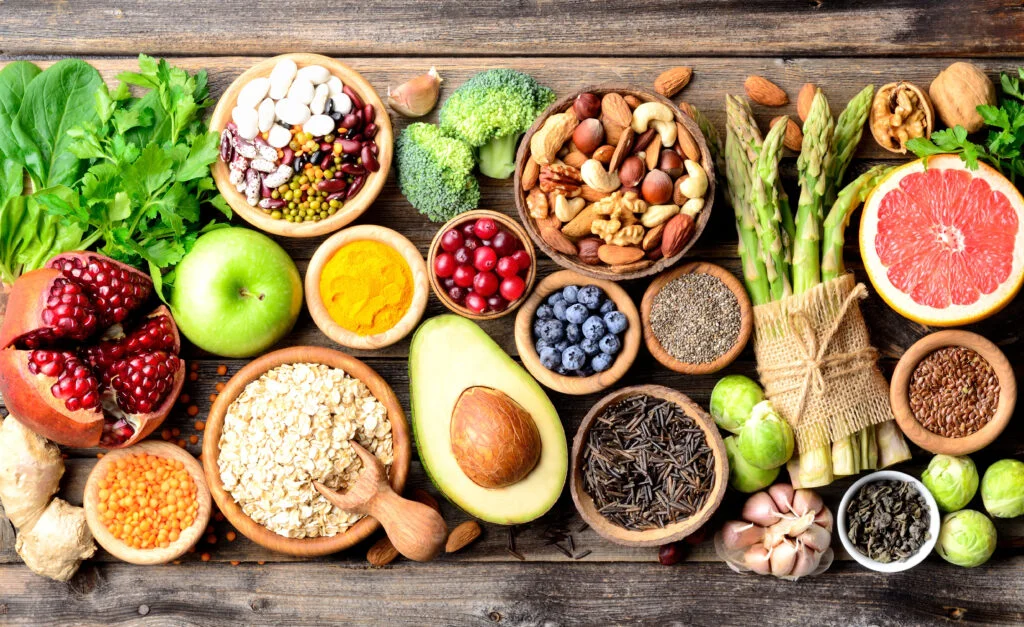
Where DO Vegans Get Their Protein?
By Natalie Pape, MA RDN
“Where do you get your protein?”
Ah, the infamous question every plant-based eater is guaranteed to hear when meat is excluded from their plate. It’s basically a vegan birthright.
Many people, including athletes, still believe large amounts of protein, especially protein coming from animals, is a necessary part of the equation for building muscle, reaching fitness goals, or simply maintaining good health. Eating muscle makes muscle, right?
Not quite.
Protein is often still synonymous with meat and animal products, but vegans, including bodybuilders and athletes, can get all the protein they need from plants.
After all, if elephants and rhinos (some of the biggest, most muscular animals on the planet) can get their protein from plants, then surely we can too.
“But we’re people, not savannah-grazing animals!” I hear you say.
Fair point. Get ready for the mother of all vegan protein articles….
What even is protein, why does it matter for vegan athletes, and where DO you get your protein on a vegan diet?
What Is Protein?
Dietary protein is one of the three macronutrients, alongside fats and carbohydrates, that make up our daily caloric intake.
Proteins are crucial for our bodies since they give us the form, or ‘building blocks’ called amino acids, for most of the body’s tissues.
Like one of those massive, intricate Lego sets, your body is constantly reordering, refolding, and joining these amino acid pieces together to form whatever it needs to build or repair at the time.
But instead of a kick-ass Death Star or Hogwarts castle, these amino acids form muscle, tendons, hormones, enzymes, DNA and RNA, red blood cells, immune cells, hair, skin, and even produces energy to some extent – your body is like the ultimate work of architecture, automatically assembled through various processes that combine those amino acid building blocks into complicated protein structures.
When a particular amino acid is needed to put a protein together, it can be taken from amino acid ‘pools’ that exist in the gut, muscle, and blood. These pools of amino acids come from the food consumed in the previous meal and from the digestion of our own enzymes and dead gut cells that slough off.
This pool is less than one percent of the body’s total protein content (more of a protein puddle, really!), which means we don’t store protein in the same way as we do with the other macronutrients like carbohydrates (as glycogen in the muscles and liver) and fats (as triglycerides in adipose, or fat tissue).
Since the protein pool is so small, getting a good amount of daily protein for our needs is essential for muscle building, or in any state where the body will need to build and repair tissues.
If we don’t, the amino acids needed for building new proteins will be taken from tissues we’d like to maintain by breaking down our muscle, and with it, our sweet, sweet gains.
More on Amino Acids
There are twenty different amino acids with different chemical compositions, but they all contain carbon, hydrogen, oxygen and, most importantly, at least one nitrogen-containing amino group, the very reason amino acids are called amino acids.
Nine of the twenty amino acids cannot be made by our bodies, so we must get them from food. These are aptly named essential amino acids because it is, well, essential that we obtain them from our diets— a tip of the hat to you, naming gods.
Fun fact: Every one of the essential amino acids is present in all plant foods, however, the ratios of each varies from one plant to another. As a general rule, legumes are lower in the amino acid methionine while grains and most other plants foods are lower in lysine, and vice-versa.
Other amino acids are called conditional or conditionally indispensable because the body can synthesize them on its own, but this synthesis may be limited during certain times of growth or disease.
If enough nitrogen (remember, that is the important component in amino acids) is consumed in the diet, our bodies can make the rest of the non-essential amino acids on their own.
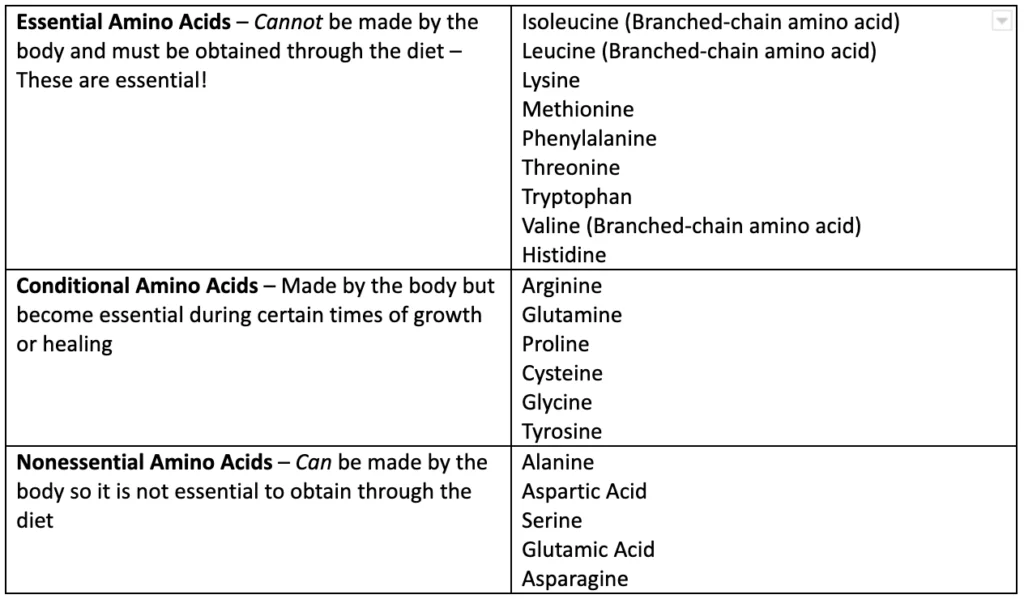
Incomplete Protein, Protein Quality, and The Protein Combining Myths
Critics of plant-based diets assert that plant proteins are incomplete, meaning they don’t provide enough of all the amino acids our bodies need and are therefore of lower protein quality compared to animal-based proteins (Poor plant proteins, haters ‘gonna hate).
In other words, complete proteins include a fuller range of amino acids that closely mimic the amino acid ratios found in human proteins, so these are referred to as high-quality proteins.
This illustrious title is often attributed to the proteins in meat, eggs, and dairy, but a few plant foods fit this category too, like soy foods (including tofu, tempeh, edamame, and soy-based meat analogs), quinoa, buckwheat, amaranth, hemp, chia seeds, and blue-green algae like spirulina.
Still, most plants don’t make the list, so a commonly held belief is that low-quality, incomplete plant proteins need to be combined to complete them, unlike animal-based proteins do.
Do vegans have to worry about combining proteins to complete them and is plant protein inadequate?
The concept for the ‘incomplete’ label originates from studies conducted with baby rats in the early and mid-twentieth century, of all things.
It may go without saying, but rats have significantly different physiology and growth rates from humans (they have a full body of fur, after all) and need highly concentrated forms of protein to thrive.
Rat milk has ten times more protein than human breast milk, which makes sense since they grow about ten times faster than human infants do. They will die if given human breast milk, even though this would obviously be perfectly suitable for human babies.
In these historical experiments, the rats were given a single protein source (like wheat or cheese alone), and not too surprisingly, the diet composed of a single plant food did not sustain the very fast growth rate of the baby rats who double their birth weight in a few days and grow to maturity in a few weeks – nothing like any humans I know of.
This led scientists of this era to brand plant protein as “inferior” and “incomplete,” in comparison to animal-based protein.
The classification of plant proteins as being inadequate is both unfortunate and misleading, and the concern of amino acid deficiency in vegetarians and vegans has been substantially overstated.
It is true that plant proteins generally have lower levels of the amino acids leucine, methionine, lysine, and tryptophan, and diets based on a protein source from a single plant food do not promote optimal growth.
This is because the single plant source does not typically supply enough of all the essential amino acids for protein synthesis. For example, most seeds and legumes provide lots of lysine, but are lower in methionine, while grains tend to be good sources of methionine, but are low in lysine.
While it is true that certain plants are lower in essential amino acids than others, using the label of ‘incomplete’ is misguided since a diet whose dietary protein is made up entirely of a variety of plants does indeed supply ‘complete’ protein or the necessary blend of all essential amino acids.
In fact, the essential amino acids present in animal products are all provided by plants either directly or indirectly, since animals either eat plants themselves or eat animals who eat plants.
Whichever way you slice it, plants are the starting line for essential amino acids, and people do not need to consume animals to obtain or complete them.
Either way, our bodies are smart and the free amino acids available in our body’s amino acid pool (puddle!) do all the necessary combining or complementing for us.
When a diet consists of a range of plant foods with complementary ratios of amino acids, it supplies the correct mix necessary to build and maintain health and strength.
It’s worth mentioning that the fiber in plant proteins, along with beneficial phytochemicals and antioxidants, brings with it a ton of advantages that animal proteins lack.
It is no wonder then that diets higher in plant proteins are shown to reduce chronic disease risk. Study after study after study after study indicates that a higher plant protein intake and a lower intake of animal proteins likely contribute to the lower disease risk seen with plant-based diets.
Perhaps the discussion and definition on “quality” of protein-rich foods have been too focused on their availability of essential amino acids.
A more modern definition should be one, perhaps, that considers overall diet quality and long-term health of specific protein sources, as well as their environmental impacts.
This early initial branding of plant-proteins as ‘incomplete’ mislead people to jump on the bandwagon of one of the biggest myths attached to plant protein: that you must combine protein sources at every meal to complete them.
Anyone else conjuring an image of a bean saying “you complete me” romcom-style to a grain of rice?
The fear was that the combination of essential amino acids from plants does not match what is required by the body for what it needs to build unless an effort was specifically made, per meal, to complement them.
Frances Moore Lappe, a sociologist with a goal of ending world hunger, popularized this idea of protein combining in her 1970’s book ‘Diet for a Small Planet.’ While Frances may have had good intentions out of concern for her fellow vegetarians, we now know protein combining is completely (get it?) unnecessary.
She has since corrected her statements in recent editions: “In combating the myth that meat is the only way to get high-quality protein, I reinforced another myth.”
Good on ya, Frances.
This idea became popular in the media and has continued to follow plant protein around for decades. Even doctors and medical professionals were taught the theory in nutrition classes; some still may be.
Luckily, this is the protein myth section for a reason, as it is now well established that vegans can easily get the full range of essential amino acids by consuming a variety of plant foods over the course of a day, rather than focusing on combining foods at each meal.
This once widely-held belief has been dismissed, replaced with the simple recommendation to simply eat protein-rich plants over the course of a day.
Overall food variety is important, but there doesn’t have to be a focus on combining complementary plants per meal. When you eat beans and grains within the same twenty-four hours, for example, amino acids take a dive into that amino acid pool (puddle!) that the body draws from all day to build the proteins you need.
Stressing out about amino acid balance at each meal is not necessary because whatever amino acids were low in one meal can be buffered, at least over the short term, by the amino acid pool.
Whatever the theory, in practice, plant-based eaters mix food groups and amino acids at meals all the time without even trying, so getting a proper mix of amino acids tends to happen naturally:
Tofu and rice in a stir-fry, lentils and teff injera, refried beans with rice in a burrito, black-eyed peas and cornbread, hummus and pita, peanut-butter on toast – the list is endless, as well as seriously delicious.
This provides an optimum blend of amino acids with little thought, so it’s no surprise then that the amounts and proportions of amino acids consumed by vegetarians and vegans are typically more than sufficient to meet and exceed individual daily requirements.
The overall bottom line is this: If a diet has at least a modest amount of variability, which is the case in most cultures, there are no issues regarding sufficient intakes of any individual essential amino acids from plant-based diets.
The exceptions to this rule are those diets based on very limited protein sources, for example, the protein from grains alone, or those consuming restricted diets like fruitarians—which we do not recommend at Vegan Proteins.
One of the hardest things about adopting a vegan lifestyle is the confrontation you may face from inquisitive minds in the world at large, and protein is often the go-to topic vegans are challenged with defending.
Explaining that indeed, you can get enough protein from plants alone, can be frustrating when discussions about plant-based diets are spent so focused on this one nutrient.
The quick response of many advocates, including healthcare professionals, is that “getting enough protein is a nonissue for vegans,” or that “protein deficiencies are not a concern if sufficient calories are consumed.”
While this quick response is generally true, this perspective can sometimes be too simplified.
Certain populations, like vegan athletes and older people especially, may have protein needs that require some extra thought and effort.
Even if someone isn’t technically protein-deficient from a clinical standpoint, they may be eating inadequate amounts of protein for their needs, and experiencing symptoms like low energy, loss of muscle mass, or feeling unsatisfied by meals.
Therefore, vegan athletes should first aim to meet protein recommendations and then make adjustments depending on how they feel and how they are progressing toward their goals.
That way, you can confidently say: “Yes, I get enough protein, thank you very much!”
There is also a belief that plant proteins are less digestible, with lower biological value or bioavailability compared to animal protein. Meaning, what amount of protein from food is absorbed and how many amino acids become available for our body’s use is in question.
Protein digestibility may be affected by inhibiting factors and the amount of fiber in plants’ cell walls since fiber passes through the intestinal tract possibly carrying with it a small amount of protein. So protein from whole plant foods may digest slightly less than protein from isolated sources.
However, overall protein digestibility remains a topic of debate. According to a 2019 review:
“There is very little evidence at present regarding a marked difference in protein digestibility [between plant and animal protein] in humans. The more precise data collected so far…has shown that the differences in the digestibility between plant and animal protein sources are only a few percent…While further research may be warranted to explore possible variations in the bioavailability of some specific amino acids, the body of evidence so far does not show a difference large enough to result in risk of insufficient amino acid absorption for vegetarian and plant-based diets.”
Regardless of this, current recommendations already adjust for a slight increase in protein for plant-based eaters (more on this below) as an extra precaution for whatever question may exist about bioavailability, but there still isn’t a ton of evidence suggesting it’s a concern.
Again, from the same review:
“Overall, when diets are at least slightly varied, suggestions that vegetarians to be sure to achieve a higher total protein intake than the RDA, or to pay strict attention to choosing plant foods with complementary amino acid patterns are simply over-precautious.”
How Do We Build Muscles? Can Plants Be Enough?
To build or synthesize a protein, a process called protein synthesis is initiated:
A hormone or growth factor signals a cell’s DNA to initiate processes called gene transcription and translation, the end result of which is a fully formed, bouncing baby protein.
Mazel Tov!
For exercise-induced muscle protein synthesis, specifically the process necessary to build muscle and the very thing we’re all working towards for our physique goals, a key signaling molecule called mammalian target of rapamycin or mTOR is stimulated.
What stimulates mTOR to do its thing?
Resistance training and consuming protein from food.
In other words, research suggests that dietary protein may be needed for protein synthesis not only to provide the building block raw materials but also to act as a trigger to stimulate the process of muscle protein synthesis itself.
Animal-based protein sources, like whey, are often considered a gold standard protein source for athletes and bodybuilders especially.
Whey is particularly high in the branched-chain amino acid (BCAA) leucine, which has been thought of as a key in stimulating muscle protein synthesis.
However, this theory has been debated more recently and leucine as a trigger for muscle protein synthesis may be more relevant in the context of isolated protein sources rather than protein-rich whole foods.
Either way, once the threshold for leucine is met, the source of protein doesn’t appear to matter and getting in leucine-rich foods (like soy and legumes in general, tempeh, seitan or vital wheat gluten, seaweed, pumpkin seeds) is easy to do in a vegan diet.
Overall, a great deal of research, like this meta-analysis, has found the protein in soy to be comparable to whey for gains in strength and lean body mass.
So wear the title of “Soy Boy” like a badge of honor, my friends.
How Much Protein is Enough?
Adequate protein is critical for maintaining lean body tissue and exercise performance.
Athletes require more protein than inactive people, and bodybuilders focused on those sweet gains likely have even higher requirements depending on the sport and training program.
The recommended dietary allowance (RDA) for protein is 0.83 grams of protein per kilogram of body weight per day (g/kg/day), but in their position paper statement on nutrition and athletic performance, the Academy of Nutrition and Dietetics (AND), American College of Sports Medicine (ACSM), and Dietitians of Canada (DC) recommend that protein intakes be increased by 10 percent for vegetarian and vegan athletes.
So, for vegans (without any particular fitness goals), protein intakes of at least 0.9-1.0 g/kg/day are recommended. One kilogram equals 2.2 pounds, so an active vegan who weighs 150 pounds, or about 68 kilograms, would need about 61 to 68 grams of protein per day to sustain themselves.
Most plant-based eaters easily meet or exceed recommendations for total protein intake; the 10 percent increase is suggested to compensate for any worry about reduced digestibility of protein from plant foods, relative to animal products (which is still debatable).
It is also worth mentioning that the RDA provides a generous amount of protein, which is thought to meet the nutrient requirements of 97.5 percent of average healthy people, two standard deviations higher than the actual estimated average protein requirement of 0.6 g/kg/day.
Endurance and strength athletes both require an even higher amount at 1.2-2.0 grams of protein per kilogram per day (0.55-0.91 grams per pound per day), respectively.
So, a 150-pound endurance athlete and a 150-pound strength athlete would need 81 to 102 grams, and 88 to 137 grams of protein per day, respectively.
Some fitness advocates suggest aiming for a slightly higher protein goal of one gram per pound of bodyweight, to ensure you’re still hitting the minimum even if you fall short. Plus 1 gram/1 pound is an easy metric to remember. Keep reading to see what WE recommend.
Why the extra protein? Additional protein is needed during more intense training to provide the extra building blocks to repair damage in muscle fibers, stimulate enzyme synthesis and other proteins in our cell’s mitochondria (the energy-generating powerhouses of our cells), and, of course!, promote muscle protein synthesis.

A more accurate method for figuring out your protein needs for physique goals may be from using lean body mass, rather than the weight on the scale.
This would be especially important for those who are overweight or obese since protein needs are not as high relative to body weight. In her book ‘Flexible Dieting For Vegans,’ Dani recommends aiming for 0.8-1.2 grams of protein per pound of lean body mass.
Those looking to gain muscle or who are in a building phase can stick to the lower end of this range, while older folks and those in a fat loss phase can aim for the higher end.
In addition, a low intake of both calories and carbohydrates increases protein needs.
During long bouts of exercise, athletes with low glycogen (carbohydrate) stores use twice as much protein as those with sufficient stores, because amino acids are converted to glucose under these conditions to maintain blood sugar- the body is so smart!
This is where amino acids also serve, in a small amount, as a source of energy when they are converted to blood sugar in this process called gluconeogenesis (“gluco”=sugar, “neo”=new or The One if you’re living in the Matrix, “genesis”= creation), a process which is important for extended periods of exercise or when we’re in a caloric deficit (consuming adequate carbohydrates before and/or during exercise can slow down or halt this process, preserving the amino acid pool).
Athlete or not, your protein needs are likely going to be higher if you are intentionally restricting calories to promote weight or body fat loss, like when you’re leaning out with a calorie deficit.
Timing matters: Spreading protein intake throughout the day, rather than in one or two big meals, may offer benefits for both athletes as well as older folks. Studies suggest that consuming 20 to 30 grams of protein distributed evenly over three or four meals or snacks is more effective at stimulating muscle protein synthesis over the course of a day because we can only absorb so much at a time.
More specifically, muscle protein synthesis is maximized by consuming 0.25-0.3 grams protein/kg body weight every 3-5 hours.
Bottom line: Vegan athletes should plan to include a significant source of protein at each meal to get the most protein bang for their buck, and within two hours after a training session, when muscles are most primed for repair and the amino acid pool is compromised.
Where DO Vegans Get Their Protein? What To Eat & Practical Protein Tips
Vegan athletes at greatest risk for low protein intakes are those who restrict calories or who eat few legumes, tofu, tempeh, seitan, meat alternatives, or other protein-dense foods.
Not sure how much protein is on your plate? Try tracking your intake over the course of a few days or consider signing up for personal coaching with Dani and Giacomo.
If you’re new to tracking food or that simply doesn’t work for you, use your hand as a guide — an appropriate serving of protein-rich foods is generally about the size of the palm of your hand.
To get more protein in throughout the day: Sneak plant-based protein powders into smoothies, soups, and batters, stir lentils into pasta sauce, add extra tofu to stir-fries, add your favorite beans to salads, make dressings with hummus or tahini, add nutritional yeast to popcorn and pasta dishes, choose the vegan foods with higher sources of protein like seitan and meat alternatives, tofu, tempeh, quinoa, TVP, and legumes.
For more helpful tips, check out these videos on selecting high protein vegan foods:
Examples of How to Increase Protein When Meal Planning
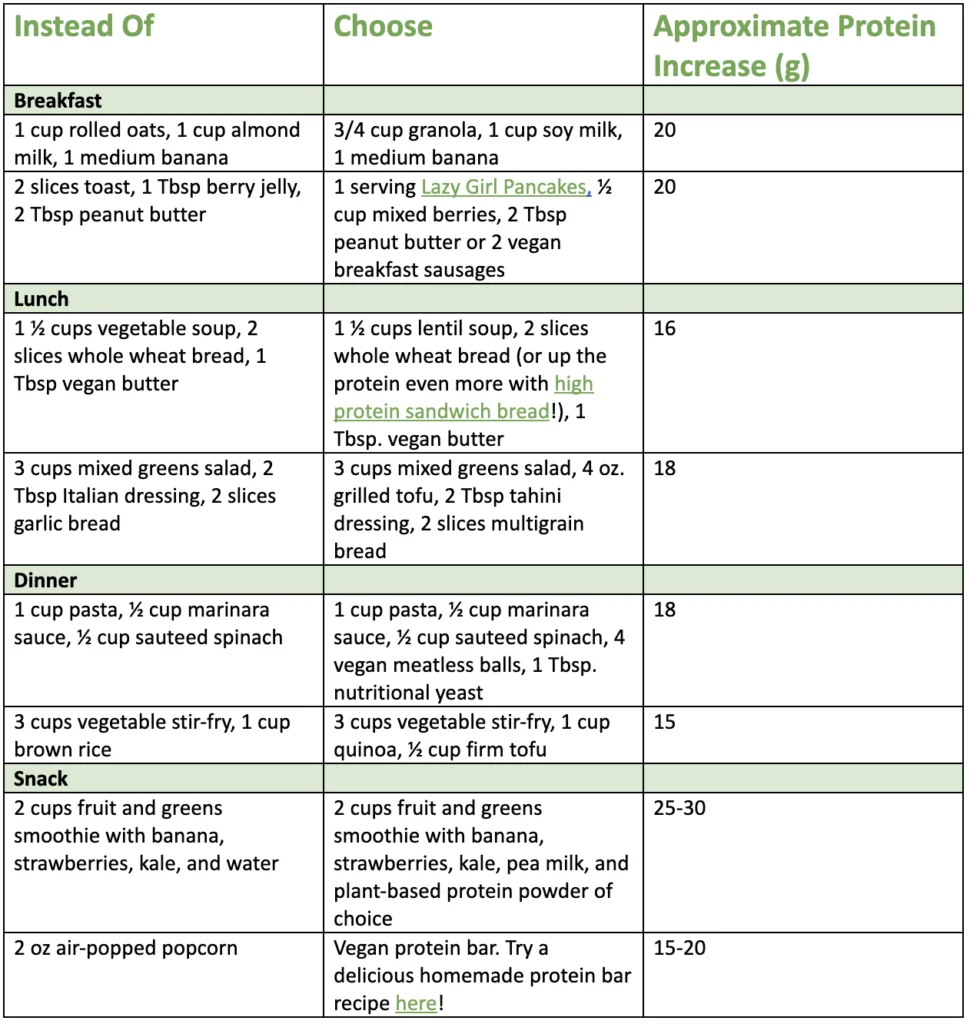
Amount of Protein in Foods
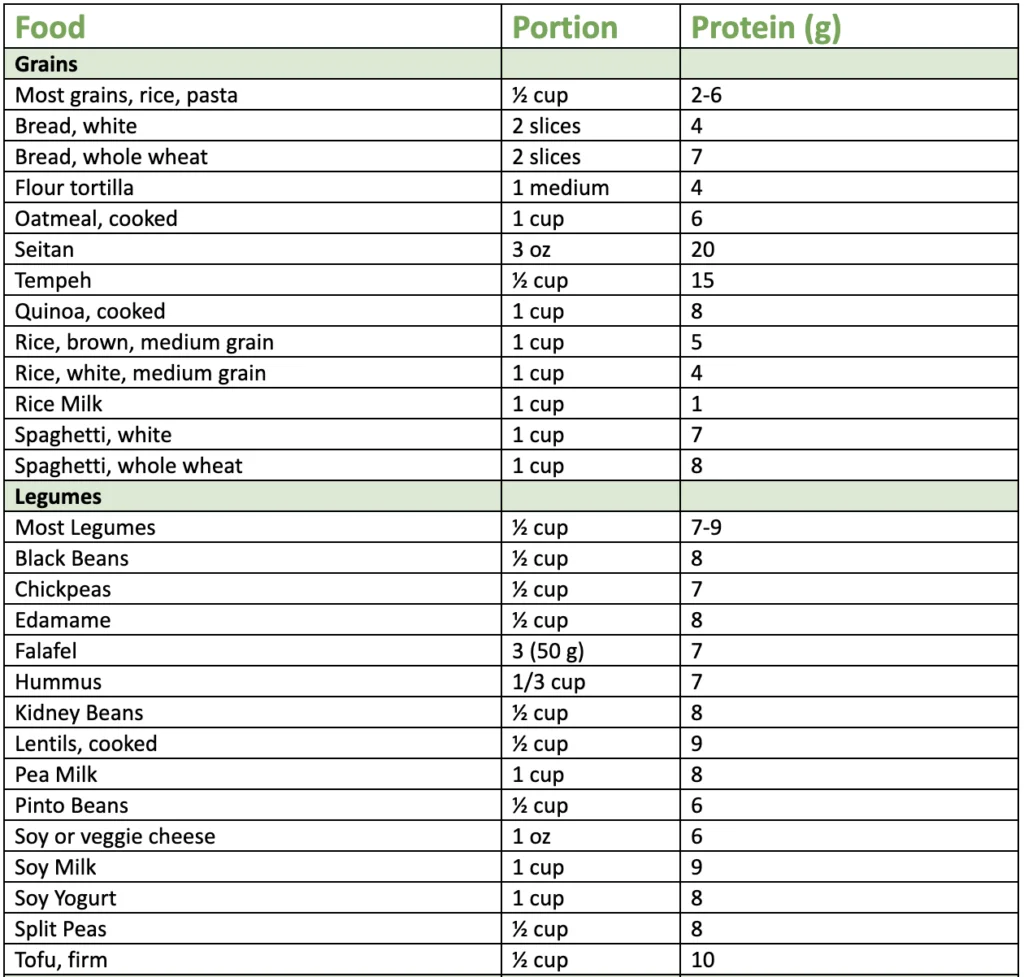
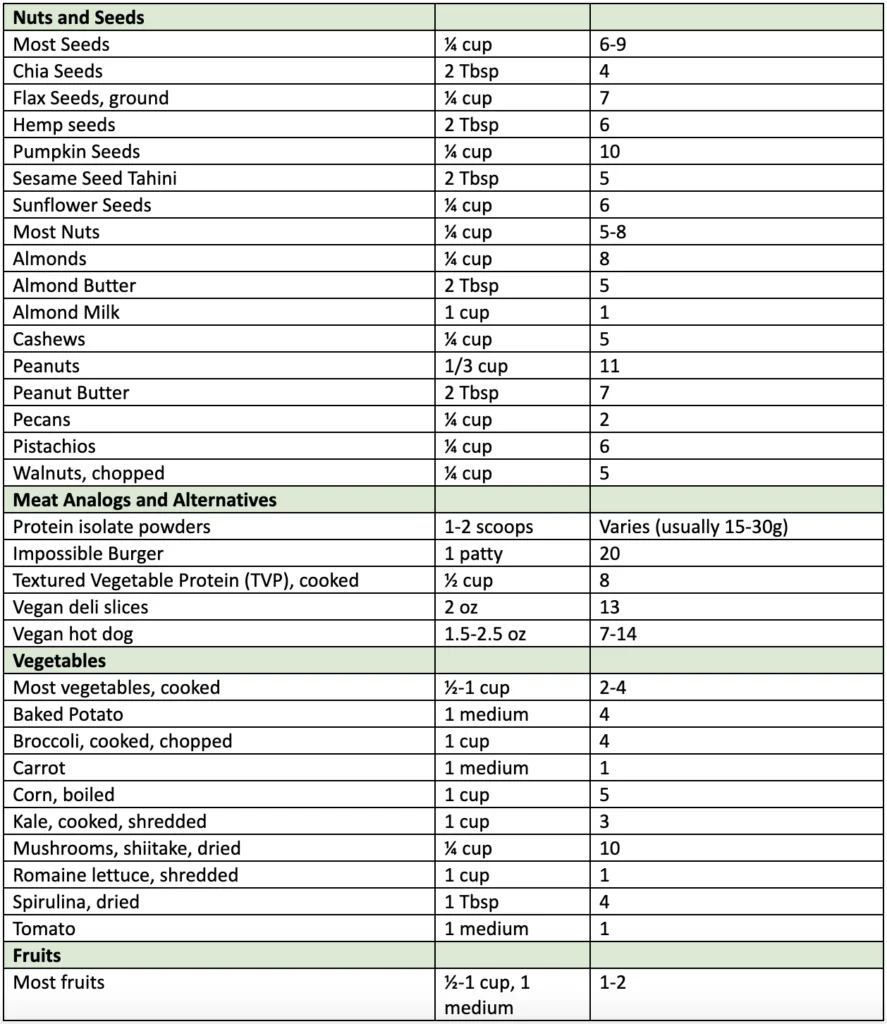
How Much is Too Much?
Dietary protein is not a magical elixir; it simply provides the amino acid building blocks necessary to make or resynthesize proteins in the body.
You will not gain strength or mass if you consume more protein than what you need, and you will not receive the training results, muscle strength, or mass gains you deserve (within the limitations set by your genes) if your diet is too low protein for your needs.
But, what happens if you do eat too much protein? Simply put, the nitrogen-containing amino group is removed from the protein’s chemical structure, so it can then be used either for energy or stored as fat.
Protein isn’t converted as quickly to carbs or fat (the two macronutrients our bodies prefer for energy) because of its higher thermic effect, or the amount of energy required to digest, absorb, transport and store.
This makes protein a much more expensive form of energy; it takes 30% of protein’s energy to digest and assimilate, 8% from carbohydrates, and 3% from fat.
Since this thermic effect of protein increases the number of calories burned through digestion, it can be an advantage to eat more protein if you’re trying to lose weight, as long as you are not exceeding your caloric needs.
Pounding those extra protein shakes won’t necessarily lead to bigger muscles – it may go straight to the hips, not the biceps, bro.
A study from the early ‘90s illustrates that extra protein does not equate to extra muscles, even in athletes who regularly participate in resistance training.
Researchers randomly assigned male strength athletes and sedentary subjects to receive one of three diets, with different amounts of protein, for close to two weeks.
One diet provided about the RDA of protein (0.86 g protein/kg body weight/day), one provided protein in the range of the current recommendation for athletes (1.4 g protein/kg body weight/day), and one provided excessive protein well above what is recommended for strength athletes (2.4 protein/kg body mass/day).
Researchers found the diet containing approximately the RDA for protein did not supply enough protein for the strength athletes, and impaired their muscle protein synthesis compared to the other two diets.
The diet providing an excessive amount of 2.4 grams of protein, however, did not increase protein synthesis any more than the diet providing 1.4 grams of protein did.
In contrast, the diet that followed the RDA recommendation supplied adequate protein for the sedentary subjects. Increasing protein intake in the sedentary men, however, did not increase protein synthesis.
A meta-analysis and systematic review of the effects of protein intakes among strength athletes found similar results. They concluded that protein intakes of up to 1.62 g/kg body weight/day, separated in doses of 0.25-0.3g/kg, increased muscle mass and increased strength during periods of sustained resistance training. However, no further benefits were found when protein intakes were higher than this.
The Bottom Line on Protein for Vegan Athletes
In the fitness world, and the world at large, a commonly held concept is that protein is the ultimate nutrient, and more is better.
A worry about getting enough protein may make athletes, especially those interested in bodybuilding, feel reluctant to adopt a vegan diet out of fear that plant protein is not sufficient for reaching strength and performance goals.
The ever-growing list of impressive vegan athletes and bodybuilders dispels whatever doubts existed that you can build muscle and strength, and reach whatever your physique goals may be, with the protein exclusively from plants.
While vegan diets provide plenty of protein for athletes, it is still a nutrient that deserves some thought and planning. We don’t call ourselves Vegan Proteins for nothin’.
While it is not necessary to eat specific combinations of plant proteins at each meal, it is important that vegan athletes consume protein-rich foods and make a conscious effort to include a variety of plant-based protein sources in their diet.
We at Vegan Proteins are here to help you do just that.
Sources
- Clarys P., Deliens T., Huybrechts I., Deriemaeker P., Vanaelst B., De Keyzer W., Hebbelinck M., Mullie P. Comparison of nutritional quality of the vegan, vegetarian, semi-vegetarian, pesco-vegetarian and omnivorous diet. Nutrients. 2014;6:1318–1332.
- Davis B, Melina V. Becoming Vegan: Comprehensive Edition. Summertown, TN: Book Publishing Co; 2014..
- Gardner C.D., Hartle J.C., Garrett R.D., Offringa L.C., Wasserman A.S. Maximizing the intersection of human health and the health of the environment with regard to the amount and type of protein produced and consumed in the United States. Nutr. Rev. 2019; 77:197–215
- Katz D.L., Doughty K.N., Geagan K., Jenkins D.A., Gardner C.D. Perspective: The public health case for modernizing the definition of protein quality. Adv. Nutr. 2019;10:755–764.
- Lernon PW, Mullin JP. Effect of initial muscle glycogen levels on protein catabolism during exercise. J. Appl. Physiol. Respir. Environ. Exerc. Physiol. 1980; 48(4):624-629.
- Tarnopolsky MA, Atkinson SA, MacDougall JD, Chesley A, Phillips S, Schwarcz HP. Evaluation of protein requirements for trained strength athletes. J. Appl. Physiol. 1985.1992;73(5):1986-1995.
- Mariotti, F., & Gardner, C. D. Dietary Protein and Amino Acids in Vegetarian Diets-A Review. Nutrients. 2019;11(11), 2661.
- Mariotti F. Plant protein, animal protein, and protein quality. Vegetarian and Plant-Based Diets in Health and Disease Prevention. Academic Press; Cambridge, MA, USA: 2017.
- Morton TW, Murphy KT, McKellar SR, et al. A systematic review, meta-analysis and meta-regression of the effect of protein supplementation on resistance training-induced gains in muscle mass and strength in healthy adults. Br J Sports Med. 2019;52(6):376-384.
- Melina V., Craig W., Levin S. Position of the Academy of Nutrition and Dietetics: Vegetarian diets. J. Acad. Nutr. Diet. 2016;116:1970–1980.
- Messina M, Lynch H, Dickinson JM, Reed KE. No difference between the effects of supplementing with soy protein versus animal protein on gains in muscle mass and strength in response to resistance exercise. Int. J. Sport. Nutr. Exerc. Metab. 2018;1-36.
- Mamerow MM, Mettler JA, English KL, et al. Dietary protein distribution positively influences 24-h muscle protein synthesis in healthy adults. J. Nutr. 2014;144(6):876-880.
- Paddon-Jones D, Leidy J. Dietary protein and muscle in older persons. Curr. Opin. Clin. Nutr. Metab. Care. 2014;17(1):5-11.
- Thomas DT, Erdman KA, Burke LM. Position of the Academy of Nutrition and Dietetics, Dietitians of Canada, and the American College of Sports Medicine: Nutrition and Athletic Performance. J. Acad. Nutr. Diet 2016;116:501-528.
- Phillips SM, Van Loon LJ. Dietary protein for athletes: from requirements to optimum adaptation. J. Sports. Sci. 2011;29 Suppl 1;S29-38
- Shang X., Scott D., Hodge A.M., English D.R., Giles G.G., Ebeling P.R., Sanders K.M. Dietary protein intake and risk of type 2 diabetes: Results from the Melbourne Collaborative Cohort Study and a meta-analysis of prospective studies. Am. J. Clin. Nutr. 2016;104:1352–1365.
- Song M., Fung T.T., Hu F.B., Willett W.C., Longo V.D., Chan A.T., Giovannucci E.L. Association of animal and plant protein intake with all-cause and cause-specific mortality. JAMA Intern. Med. 2016
- Tian S., Xu Q., Jiang R., Han T., Sun C., Na L. Dietary protein consumption and the risk of type 2 diabetes: A systematic review and meta-analysis of cohort studies. Nutrients. 2017;9:982.
- Tharrey M., Mariotti F., Mashchak A., Barbillon P., Delattre M., Fraser G.E. Patterns of plant and animal protein intake are strongly associated with cardiovascular mortality: The adventist health study-2 cohort. Int. J. Epidemiol. 2018
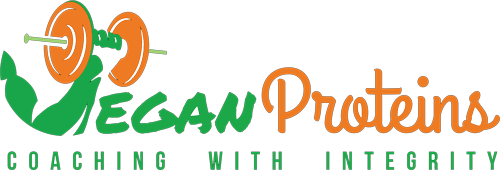
1 Comment.
[…] What surprises most omnivores is that getting enough protein isn’t usually an issue. Majority of Americans actually consume way more protein than they need in a normal diet. The average woman needs about 46 grams a day while the average man needs 56, but the average American consumes anywhere from 70-100 grams a day. As a vegan, you get adequate amounts of protein from beans, nuts, and many vegetables (provided you actually eat those things and don’t live off of pasta and bread.) If you’re worried about getting enough, check out this article written by a vegan bodybuilder. […]